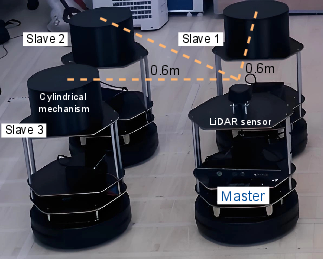Multi-robot Rigid Formation Navigation via Synchronous Motion and Discrete-time Communication-Control Optimization (2510.02624v2)
Abstract: Rigid-formation navigation of multiple robots is essential for applications such as cooperative transportation. This process involves a team of collaborative robots maintaining a predefined geometric configuration, such as a square, while in motion. For untethered collaborative motion, inter-robot communication must be conducted through a wireless network. Notably, few existing works offer a comprehensive solution for multi-robot formation navigation executable on microprocessor platforms via wireless networks, particularly for formations that must traverse complex curvilinear paths. To address this gap, we introduce a novel "hold-and-hit" communication-control framework designed to work seamlessly with the widely-used Robotic Operating System (ROS) platform. The hold-and-hit framework synchronizes robot movements in a manner robust against wireless network delays and packet loss. It operates over discrete-time communication-control cycles, making it suitable for implementation on contemporary microprocessors. Complementary to hold-and-hit, we propose an intra-cycle optimization approach that enables rigid formations to closely follow desired curvilinear paths, even under the nonholonomic movement constraints inherent to most vehicular robots. The combination of hold-and-hit and intra-cycle optimization ensures precise and reliable navigation even in challenging scenarios. Simulations in a virtual environment demonstrate the superiority of our method in maintaining a four-robot square formation along an S-shaped path, outperforming two existing approaches. Furthermore, real-world experiments validate the effectiveness of our framework: the robots maintained an inter-distance error within $\pm 0.069m$ and an inter-angular orientation error within $\pm19.15{\circ}$ while navigating along an S-shaped path at a fixed linear velocity of $0.1 m/s$.
Sponsored by Paperpile, the PDF & BibTeX manager trusted by top AI labs.
Get 30 days freePaper Prompts
Sign up for free to create and run prompts on this paper using GPT-5.
Top Community Prompts
Collections
Sign up for free to add this paper to one or more collections.





